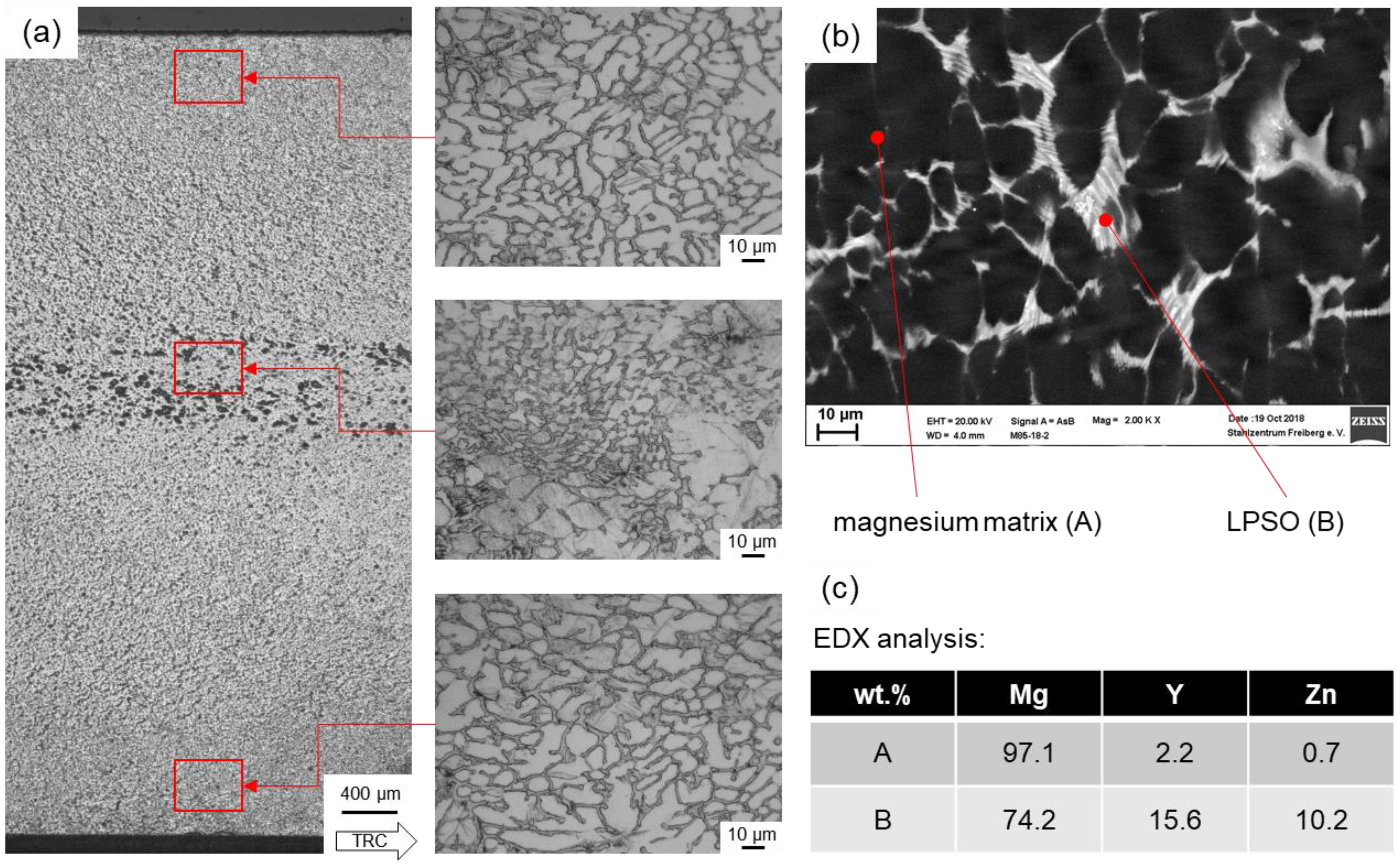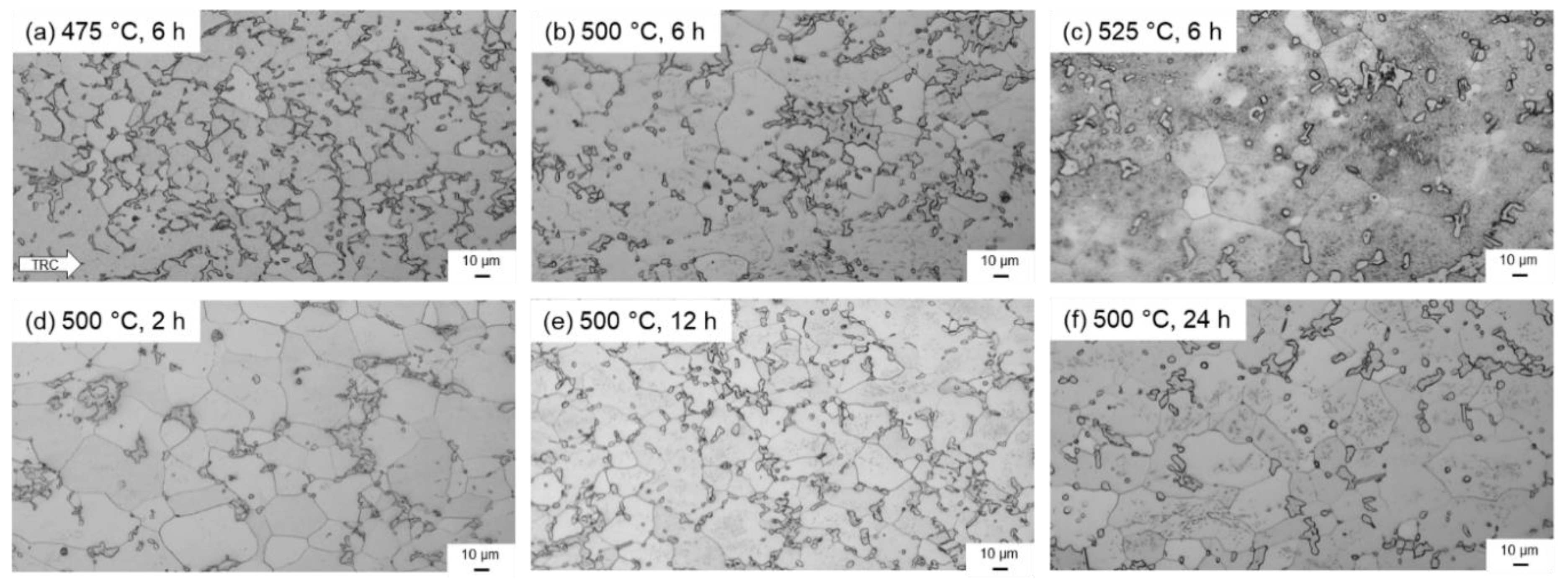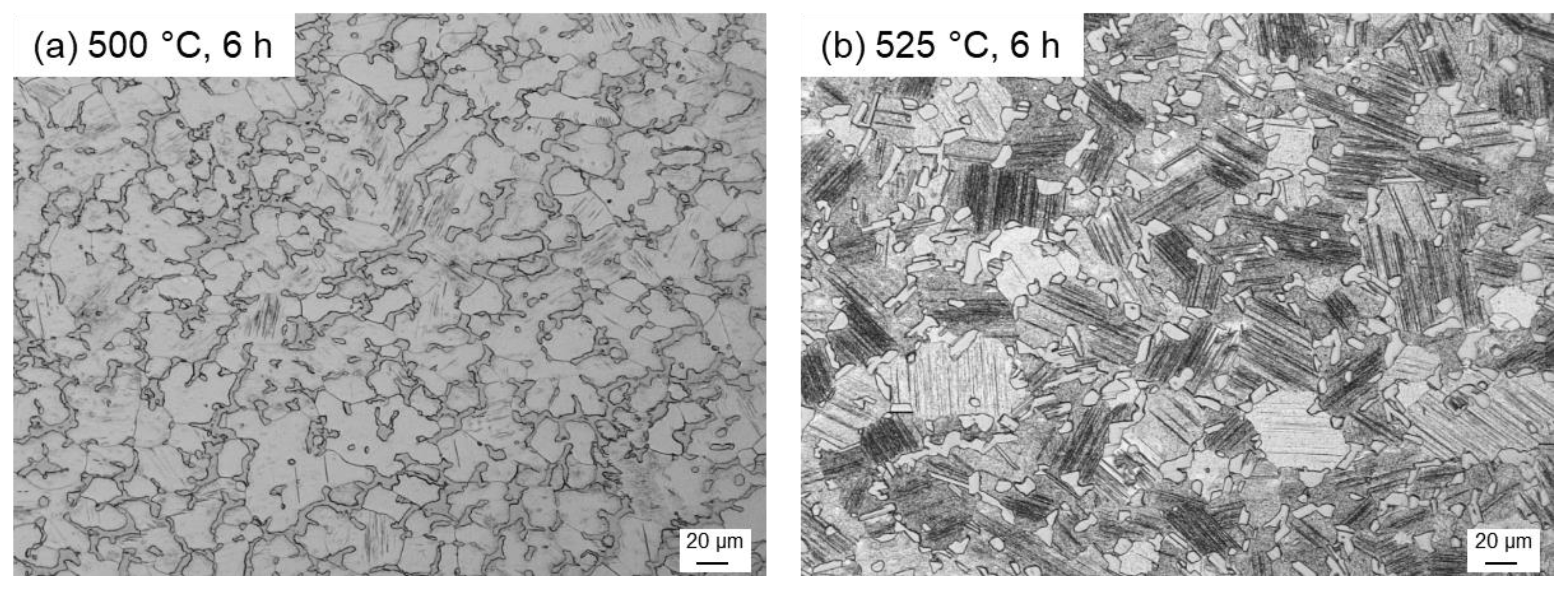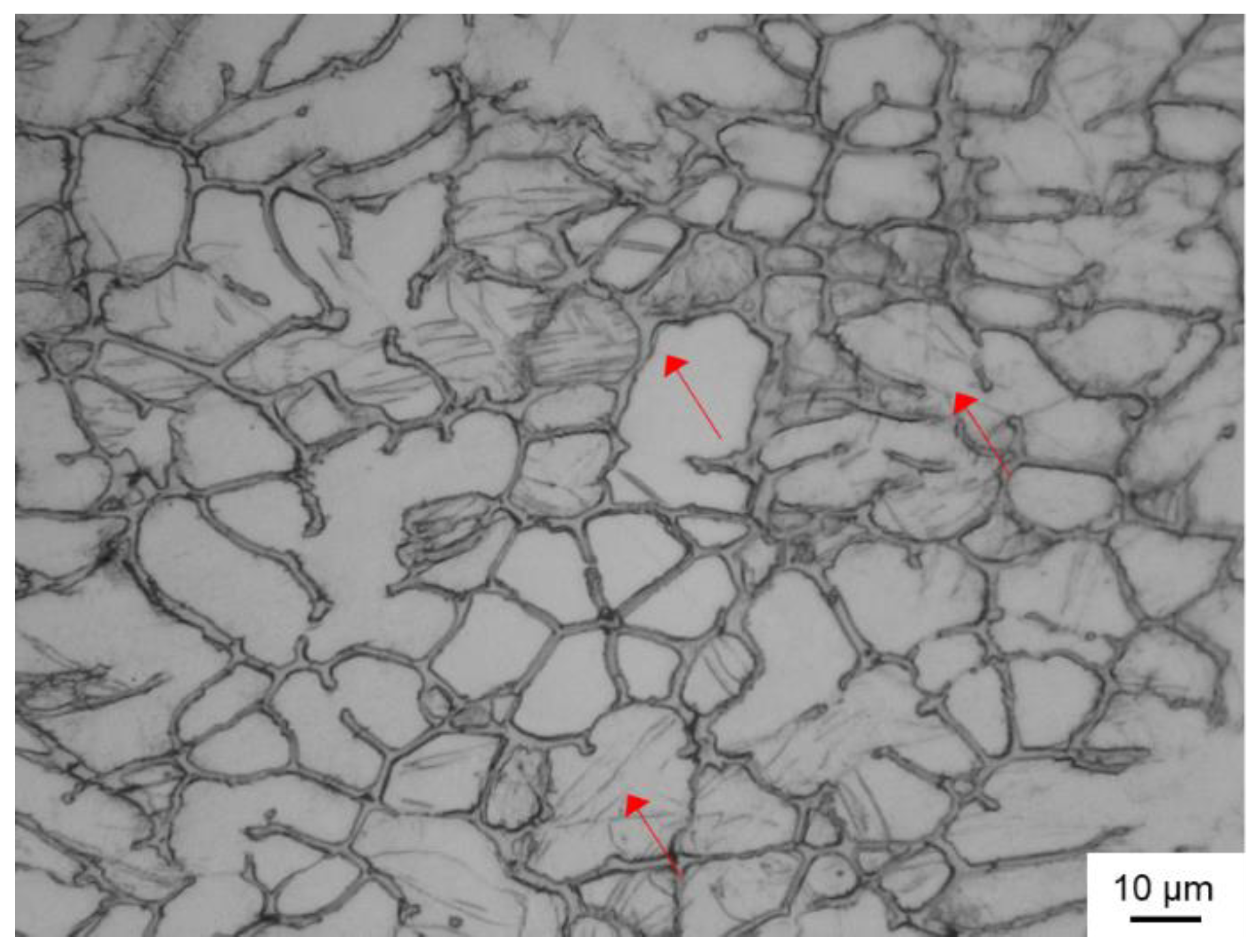Microstructure and Texture Evolution during Twin-Roll Casting and Annealing of a Mg–6.8Y2.5Zn–0.4Zr Alloy (WZ73)
Abstract
1. Introduction
2. Materials and Methods
3. Results and Discussion
3.1. Microstructure of Twin-Roll Cast State
3.2. Microstructure of Annealed State
3.3. Texture Evolution
4. Conclusions
- Twin-roll casting of the WZ73 alloy led to the formation of a two-phase microstructure consisting of an α-magnesium matrix and the LPSO phase, which was located as a network-like phase along the grain boundaries of the matrix grains. The characteristic microstructure of columnar dendrites growing from the surface edge to the mid-thickness of the TRC strips—which typically develops during twin-roll casting of magnesium alloys and was reported for AZ31 and ZAX210—was not observed;
- The most important difference between the as-cast (reported in the literature) and the TRC state is that after conventional casting, fine lamellar structures could be observed within the magnesium matrix. Lamellae of the LPSO structure within the Mg matrix did not occur after TRC;
- Annealing of the twin-roll cast WZ73 alloy led to partial dissolution of the LPSO structures into the matrix. The continuous network of the LPSO structures diminished and the grain boundaries of the magnesium matrix could be observed. Annealing temperatures of 500 °C or 525 °C with a holding time of 24 h resulted in the segmentation of the LPSO structures, with the morphology changing significantly from block-shaped to a globular and rod-like shape;
- After heat treatment at 525 °C, fine lamellar LPSO structures precipitated within the grains of the magnesium matrix. Those lamellae are known from microstructures of LPSO-containing magnesium alloys after conventional casting. It was therefore assumed that annealing at high temperatures resulted in the dissolution of the network-shaped LPSO phase during the holding time and led to the formation of fine lamellae of LPSO structures within the magnesium matrix, which could be assigned to the 14H phase;
- In the TRC strip, the (0001) pole figure exhibited a basal texture character, because most of the crystals were oriented with their basal planes parallel to the sheet plane. However, the maximum intensity was low. Heat treatment at 500 °C for two hours led to weakening of the texture. The maximal pole intensity was separated into several basal poles, which were aligned away from the core intensity. Angular distribution of the basal planes in the TRC direction as well as in the TD could also be observed.
Author Contributions
Funding
 |
Acknowledgments
Conflicts of Interest
References
- Wan, Y.; Liu, C.; Xiao, H.; Gao, Y.; Jiang, S.; Chen, Z. Improving the Ductility of Mg-Gd-Y-Zr Alloy through Extrusion and a Following Rolling. Adv. Eng. Mater. 2018, 20, 1701041. [Google Scholar] [CrossRef]
- Shao, X.H.; Yang, Z.Q.; Ma, X.L. Strengthening and toughening mechanisms in Mg–Zn–Y alloy with a long period stacking ordered structure. Acta Mater. 2010, 58, 4760–4771. [Google Scholar] [CrossRef]
- Li, Y.X.; Zhu, G.; Qiu, D.; Yin, D.D.; Rong, Y.H.; Zhang, M.-X. The intrinsic effect of long period stacking ordered phases on mechanical properties in Mg-RE based alloys. J. Alloys Compd. 2016, 660, 252–257. [Google Scholar] [CrossRef]
- Kishida, K.; Nagai, K.; Matsumoto, A.; Yasuhara, A.; Inui, H. Crystal structures of highly-ordered long-period stacking-ordered phases with 18R, 14H and 10H-type stacking sequences in the Mg–Zn–Y system. Acta Mater. 2015, 99, 228–239. [Google Scholar] [CrossRef]
- Hagihara, K.; Kinoshita, A.; Sugino, Y.; Yamasaki, M.; Kawamura, Y.; Yasuda, H.Y.; Umakoshi, Y. Effect of long-period stacking ordered phase on mechanical properties of Mg97Zn1Y2 extruded alloy. Acta Mater. 2010, 58, 6282–6893. [Google Scholar] [CrossRef]
- Liu, H.; Xue, F.; Bai, J.; Sun, Y. Effect of heat treatments on the microstructure and mechanical properties of an extruded Mg95.5Y3Zn1.5 alloy. Mater. Sci. Eng. A 2013, 585, 261–267. [Google Scholar] [CrossRef]
- Kim, K.-H.; Lee, J.G.; Bae, G.T.; Bae, J.H.; Kim, N.J. Mechanical Properties and Microstructure of Twin-Roll Cast Mg-Zn-Y Alloy. Mater. Trans. 2008, 49, 980–985. [Google Scholar] [CrossRef]
- Li, R.G.; Fang, D.Q.; An, J.; Lu, Y.; Cao, Z.Y.; Liu, Y.B. Comparative studies on the microstructure evolution and fracture behavior between hot-rolled and as-cast Mg96ZnY3 alloys. Mater. Charact. 2009, 60, 470–475. [Google Scholar] [CrossRef]
- Wang, B.S.; Xiong, S.; Liu, Y. Tensile fracture of as-cast and hot rolled Mg-Zn-Y alloy with long-period stacking phase. Trans. Nonferr. Met. Soc. 2010, 20, s488–s492. [Google Scholar] [CrossRef]
- Suzawa, K.; Inoue, S.I.; Nishimoto, S.; Fuchigami, S.; Yamasaki, M.; Kawamura, Y.; Yoshida, K.; Kawabe, N. High-strain-rate superplasticity and tensile behavior of fine-grained Mg97Zn1Y2 alloys fabricated by chip/ribbon-consolidation. Mater. Sci. Eng. A 2019, 764, 138179. [Google Scholar] [CrossRef]
- Zhu, Y.M.; Morton, A.J.; Nie, J.F. The 18R and 14H long-period stacking ordered structures in Mg–Y–Zn alloys. Acta Mater. 2010, 58, 2936–2947. [Google Scholar] [CrossRef]
- Zhu, Y. Microstructural Characterization of Mg-Y-Zn Based Alloys. Ph.D. Thesis, Monash University, Melbourne, Australia, 2011. [Google Scholar]
- Kim, J.K.; Sandlöbes, S.; Raabe, D. On the room temperature deformation mechanisms of a Mg–Y–Zn alloy with long-period-stacking-ordered structures. Acta Mater. 2015, 82, 414–423. [Google Scholar] [CrossRef]
- Itoi, T.; Inazawa, T.; Yamasaki, M.; Kawamura, Y.; Hirohashi, M. Microstructure and mechanical properties of Mg–Zn–Y alloy sheet prepared by hot-rolling. Mater. Sci. Eng. A 2013, 560, 216–223. [Google Scholar] [CrossRef]
- Frank, F.C.; Stroh, A.N. On the theory of kinking. Proc. Phys. Soc. Sect. B 1952, 65, 811–821. [Google Scholar] [CrossRef]
- Ashby, M.F.; Gelles, S.H.; Tanner, L.E. The stress at which dislocations are generated at a particle-matrix interface. Philos. Mag. 1969, 19, 757–771. [Google Scholar] [CrossRef]
- Yamasaki, M.; Hashimoto, K.; Hagihara, K.; Kawamura, Y. Effect of multimodal microstructure evolution on mechanical properties of Mg–Zn–Y extruded alloy. Acta Mater. 2011, 59, 3646–3658. [Google Scholar] [CrossRef]
- Shi, B.; Chen, R.; Ke, W. Effects of processing route on texture and mechanical properties of WZ62 alloy. Trans. Nonferrous Met. Soc. China 2011, 21, 830–835. [Google Scholar] [CrossRef]
- Xu, D.; Han, E.; Xu, Y.B. Effect of long-period stacking ordered phase on microstructure, mechanical property and corrosion resistance of Mg alloys: A review. Prog. Nat. Sci. Mater. Int. 2016, 26, 117–128. [Google Scholar] [CrossRef]
- Lv, B.-J.; Peng, J.; Zhu, L.-L.; Wang, Y.-J.; Tang, A.-T. The effect of 14H LPSO phase on dynamic recrystallization behavior and hot workability of Mg–2.0Zn–0.3Zr–5.8Y alloy. Mater. Sci. Eng. A 2014, 599, 150–159. [Google Scholar] [CrossRef]
- Liu, H.; Huang, H.; Wang, C.; Sun, J.; Bai, J.; Xue, F.; Ma, A.; Chen, X.B. Recent Advances in LPSO-Containing Wrought Magnesium Alloys: Relationships Between Processing, Microstructure, and Mechanical Properties. JOM 2019, 71, 3314–3327. [Google Scholar] [CrossRef]
- Liu, J.B.; Zhang, K.; Han, J.T.; Li, X.G.; Li, Y.J.; Ma, M.L.; Yuan, J.W.; Shi, G.L. Microstructure and texture evolution of Mg–7Y-1Nd–0.5Zr alloy sheets with different rolling temperatures. Rare Met. 2016, 14, 16. [Google Scholar] [CrossRef]
- Dai, S.; Wang, F.; Wang, Z.; Liu, Z.; Mao, P. Microstructure, mechanical properties, and texture evolution of Mg–Zn–Y–Zr alloy fabricated by hot extrusion–shearing process. J. Mater. Sci. 2020, 55, 375–388. [Google Scholar] [CrossRef]
- Neh, K.; Ullmann, M.; Oswald, M.; Berge, F.; Kawalla, R. Twin roll casting and strip rolling of several magnesium alloys. Mater. Today Proc. 2015, 2, 45–52. [Google Scholar] [CrossRef]
- Kawalla, R.; Ullmann, M.; Schmidt, C.; Dembińska, J.; Vogt, H.-P. Properties of Magnesium Strips produced by Twin-Roll-Casting and Hot Rolling. In Materials Science Forum 690; Trans Tech Publications Ltd.: Stafa-Zurich, Switzerland, 2011; pp. 21–24. [Google Scholar]
- Kawalla, R.; Ullmann, M.; Oswald, M.; Vogt, H.-P. Developement of a strop rolling technology for Mg alloys based on the twin roll casting process. Magnes. Technol. 2008, 177, 182. [Google Scholar]
- Gröbner, J.; Kozlov, A.; Fang, X.Y.; Geng, J.; Nie, J.F.; Schmid-Fetzer, R. Phase equilibria and transformations in ternary Mg-rich Mg–Y–Zn alloys. Acta Mater. 2012, 60, 5948–5962. [Google Scholar] [CrossRef]
- Bachmann, F.; Hielscher, R.; Schaeben, H. Texture Analysis with MTEX—Free and Open Source Software Toolbox. Solid State Phenom. 2010, 160, 63–68. [Google Scholar] [CrossRef]
- Ullmann, M. Rekristallisationsverhalten von Geglühtem AZ31-Gießwalzband Beim Warmwalzen. Ph.D. Thesis, Technische Universität Bergakademie Freiberg, Freiberg, Germany, 2014. [Google Scholar]
- Hadadzadeh, A.; Wells, M.A. Inverse and centreline segregation formation in twin roll cast AZ31 magnesium alloy. Mater. Sci. Technol. 2015, 31, 1715–1726. [Google Scholar] [CrossRef]
- Kittner, K.; Ullmann, M.; Henseler, T.; Kawalla, R.; Prahl, U. Microstructure and Hot Deformation Behavior of Twin Roll Cast Mg-2Zn-1Al-0.3Ca Alloy. Materials 2019, 12, 1020. [Google Scholar] [CrossRef]
- Ullmann, M.; Schmidtchen, M.; Kittner, K.; Henseler, T.; Kawalla, R.; Prahl, U. Hot Deformation Behaviour and Processing Maps of an as-Cast Mg-6.8Y-2.5Zn-0.4Zr Alloy. Mater. Sci. Forum 2019, 949, 57–65. [Google Scholar] [CrossRef]
- Neh, K.; Ullmann, M.; Kawalla, R. Mechanical Properties and Microstructure of the Magnesium Alloy Mg-6.8Y-2.5Zn-0.5Al Produced by Casting and Hot Rolling. Mater. Sci. Forum 2018, 918, 3–12. [Google Scholar] [CrossRef]
- Lu, R.; Wang, J.; Chen, Y.; Qin, D.; Yang, W.; Wu, Z. Effects of heat treatment on the morphology of long-period stacking ordered phase, the corresponding damping capacities and mechanical properties of Mg–Zn–Y alloys. J. Alloys Compd. 2015, 639, 541–546. [Google Scholar] [CrossRef]
- Xu, C.; Nakata, T.; Qiao, X.; Zheng, M.; Wu, K.; Kamado, S. Effect of LPSO and SFs on microstructure evolution and mechanical properties of Mg-Gd-Y-Zn-Zr alloy. Sci. Rep. 2017, 7, 40846. [Google Scholar] [CrossRef] [PubMed]
- Wu, Y.J.; Zeng, X.Q.; Lin, D.L.; Peng, L.M.; Ding, W.J. The microstructure evolution with lamellar 14H-type LPSO structure in an Mg96.5Gd2.5Zn1 alloy during solid solution heat treatment at 773 K. J. Alloys Compd. 2009, 477, 193–197. [Google Scholar] [CrossRef]
- Kittner, K.; Ullman, M.; Henseler, T.; Prahl, U.; Kawalla, R. Dynamic recrystallization behavior of twin roll cast ZAX210 strips during hot deformation. In Proceedings of the Conference METAL 2019, Brno, Czech Republic, 22–24 May 2019. [Google Scholar]
- Tong, L.B.; Zheng, M.Y.; Cheng, L.R.; Zhang, D.P.; Kamado, S.; Meng, J.; Zhang, H.J. Influence of deformation rate on microstructure, texture and mechanical properties of indirect-extruded Mg–Zn–Ca alloy. Mater. Charact. 2015, 104, 66–72. [Google Scholar] [CrossRef]
- Chun, Y.B.; Davies, C.H.J. The evolution of in-grain misorientation axes (IGMA) during deformation of wrought magnesium alloy AZ31. In Magnesium Technology, Proceedings of the TMS 2010 Annual Meeting and Exhibition, Seattle, WA, USA, 14–18 February 2010; TMS (The Minerals, Metals & Materials Society): Warrendale, PA, USA, 2010; pp. 345–349. [Google Scholar]
- Wang, Y.; Wang, S.R.; Ma, R.; Yang, L.Y. Static Recrystallization of Magnesium Alloy during TRC-HC Deformation Followed by Annealing. In Advanced Materials Research; Trans Tech Publications Ltd.: Stafa-Zurich, Switzerland, 2011; Volume 295, pp. 730–733. [Google Scholar] [CrossRef]








| Y | Zn | Zr | Si | Fe | Ni | Cu | Others | Mg |
|---|---|---|---|---|---|---|---|---|
| 6.8 | 2.5 | 0.4 | 0.01 | 0.005 | 0.001 | 0.001 | 0.01 | Balance |
© 2020 by the authors. Licensee MDPI, Basel, Switzerland. This article is an open access article distributed under the terms and conditions of the Creative Commons Attribution (CC BY) license (http://creativecommons.org/licenses/by/4.0/).
Share and Cite
Kittner, K.; Ullmann, M.; Arndt, F.; Kawalla, R.; Prahl, U. Microstructure and Texture Evolution during Twin-Roll Casting and Annealing of a Mg–6.8Y2.5Zn–0.4Zr Alloy (WZ73). Crystals 2020, 10, 513. https://doi.org/10.3390/cryst10060513
Kittner K, Ullmann M, Arndt F, Kawalla R, Prahl U. Microstructure and Texture Evolution during Twin-Roll Casting and Annealing of a Mg–6.8Y2.5Zn–0.4Zr Alloy (WZ73). Crystals. 2020; 10(6):513. https://doi.org/10.3390/cryst10060513
Chicago/Turabian StyleKittner, Kristina, Madlen Ullmann, Falko Arndt, Rudolf Kawalla, and Ulrich Prahl. 2020. "Microstructure and Texture Evolution during Twin-Roll Casting and Annealing of a Mg–6.8Y2.5Zn–0.4Zr Alloy (WZ73)" Crystals 10, no. 6: 513. https://doi.org/10.3390/cryst10060513
APA StyleKittner, K., Ullmann, M., Arndt, F., Kawalla, R., & Prahl, U. (2020). Microstructure and Texture Evolution during Twin-Roll Casting and Annealing of a Mg–6.8Y2.5Zn–0.4Zr Alloy (WZ73). Crystals, 10(6), 513. https://doi.org/10.3390/cryst10060513









